The first time I used the XPL Oars from Duckworks I didn’t even notice them. I was focused on the performance of the company’s new 10′ skiff I was rowing during speed trials, quick sprints, and sudden stops. If I had noticed the oars, it would have been for their faults. The XPLs went unnoticed because they had none.
When I took the XPL Oars along to row my Whitehall I could turn my attention to their virtues. They are exceptionally light. The 7′ 11″ oars weigh an average 2 lbs 9.2 oz. By comparison, one of the 7′ 4″ spoon-bladed oars I made of spruce weighs 3 lbs 2.9 oz, 9.75 oz heavier for an oar that’s 7″ shorter than the XPL. The XPL blades are 23″ long and 6 7⁄8″ across at their widest point. Their basswood handles are 10″ long with a grip area 1 1⁄4″ in diameter.
 Photographs by the author
Photographs by the authorThe flexible rubber sleeve covers the joint between the oar halves and the button that locks them together.
The XPL Oars are sectional and have a built-in ferrule with a spring-loaded button to lock the two pieces together. The fit is snug and assembly requires a bit of effort, which is as it should be. There is no play in the joint. A rubber sleeve covers the joint and the button and gets curled back on itself to take the oar apart.
The looms are 1 3⁄4″ in diameter and fitted with Seadog oar collars, which are made of molded polyethylene and split down one side. They’re meant to be secured by nails to wooden oars, but for the XPLs, they’re held in place by a heavy-duty heat-shrink tubing that extends from the buttons and 1 1⁄2″ beyond the sleeves to grip the looms. The loom, plus collar and tubing, has a diameter of 2 5⁄32″, too large to fit a standard 2″ oarlock.
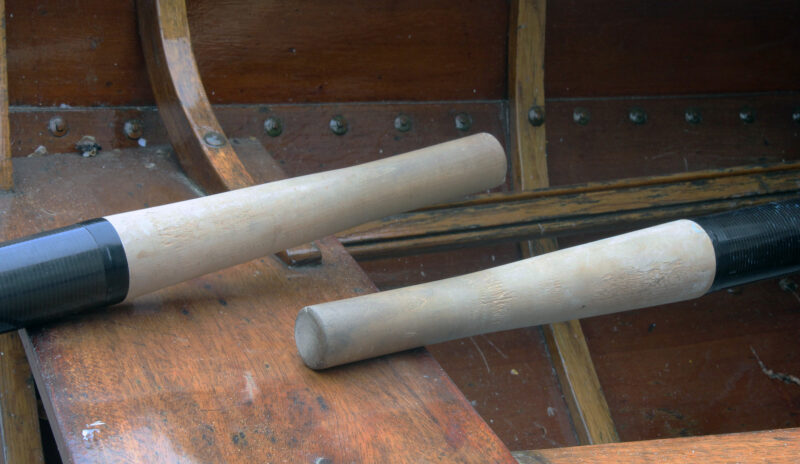
The basswood handles are left bare for a good grip even when wet.
The oars were delivered with Gaco oarlocks, sold separately by Duckworks. Designed to fit oar sleeves up to 2 1⁄4″ in diameter, these are a good fit for the XPLs. They can be slipped over the loom before the two pieces of the oar are joined, avoiding the harder task of opening the lock with a screwdriver. The Gaco locks have 10mm stainless-steel shafts and adapter sleeves to fit 1⁄2″ oarlock sockets. The adapters seemed to be a bit oversized—I couldn’t get them inserted into any of my 1⁄2″ sockets so I trimmed them down with a scraper until they had an easy slip fit. (If the fit is too tight, the adapter will come off the shaft and remain in the oarlock socket.)

The faces and the backs of the blades are gently contoured and offer little resistance to lateral movement at the catch and the finish of the stroke and during sculling.
A dab of tallow—the same lube I use with oar leathers and bronze oarlocks—provides freedom of rotation to the oars for easy feathering. At the catch, the blade’s edges, only 1⁄16″ thick, cut into the water without disturbing it and the centerline ridge on both the back and face of the blade has gentle transitions that slip beneath the surface cleanly. I could consistently make hard catches without having the blade drive any air into the puddles.
While I couldn’t feel any give in the looms during the catch and drive, there is some flex when I try to bend an XPL oar by levering it against the ground. There is enough give in the loom and the end of the blade to ease the shock on one’s hands during a hard catch. The blade doesn’t flutter during a strong pull and exits the water cleanly at the finish of the stroke.

The blades are exceptionally thin. The ends of the blades, beyond the central ridges front and back, have a bit of flexibility to ease the impact of a fast and hard catch on one’s hands.
The swing weight of the XPL Oars is exceptionally light. It takes almost no effort to move the blades from the finish to the catch, even when rowing at a high cadence. I keep the blades low on the recovery, and inevitably slap waves and wakes with the back of the blades. The blades go quickly up and over, and I can maintain a light touch on the handles.
Sculling the boat sideways with one oar was made easy by lack of lateral resistance offered by the blade’s slim profile. I kept the blade deep in the water to get the most efficient use of its thrust and it would take several seconds before the produced upwelling reached the water’s surface. I was impressed by how much water the blade could set in motion. When I took the oars apart later, some water came out of the joint, likely a result of sculling, which put the rubber sleeve between the sections low enough to allow water under pressure to seep past it. Foam plugs in the loom on both sides limit how much water can get in, and keep it from the loom’s outboard ends where it would increase the swing weight.
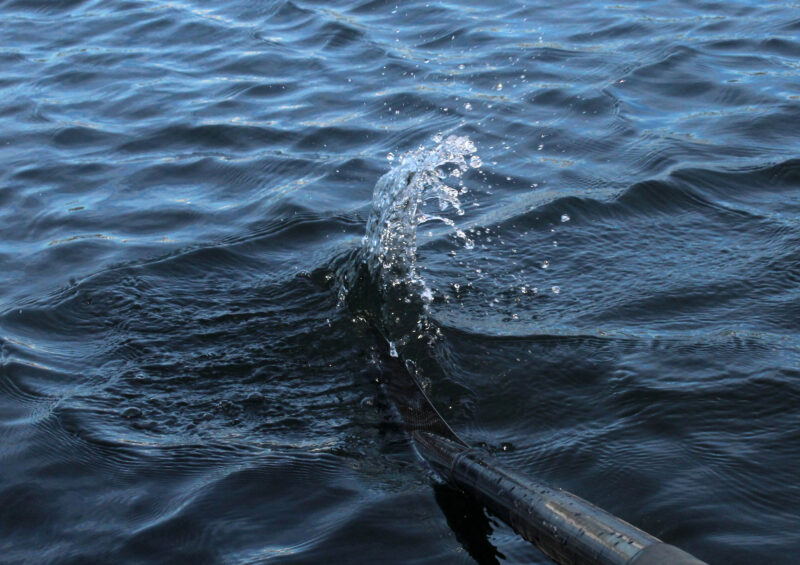
In a quick, forceful catch, the blade slips into the water without drawing any air in with it. Keeping the air out of the water reduces slip to a minimum. The water shooting upward comes from the flip catch at the instant the blade comes off the feather and full pressure is put on the blade.
After rowing the Whitehall with a fixed thwart, I switched to the sliding seat I made for the boat. The oars performed equally well with the longer stroke. I could feel the weight of the boat during the drive, an indication of how little the blades slipped in the water. I would have liked to change the gearing of the oars by moving the collars outboard a couple of inches. If you were to order the oars with the sleeves and heat-shrink tubing, you could hold the sleeves in place with tape or hose clamps until you determine the best location and gearing for your boat.
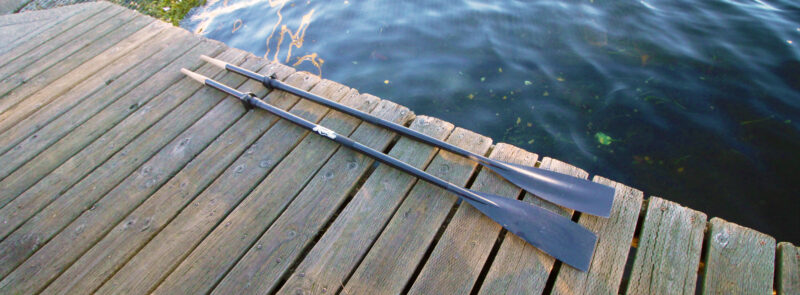
The XPL Oars are available in any length from 6′ to 9′ 6″.
The XPL Oars perform very well during all phases of the stroke and are a great pleasure to row with. They have only one flaw: The feather-light touch they require on the recovery is going to make the oars I’ve been enjoying for decades seem clunky.![]()
Christopher Cunningham is the editor of Small Boats.
XPL Oars are made and sold by Duckworks for $850. They can be ordered in any length between 6′ and 9′6″. The rubber sleeve kit is a $30 option. The 1⁄2″ Gaco oarlocks are sold separately for $42.99.
Is there a product that might be useful for boatbuilding, cruising, or shore-side camping that you’d like us to review? Please email your suggestions.


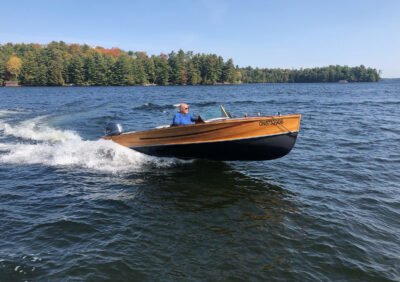



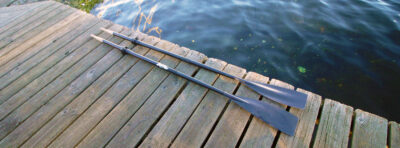




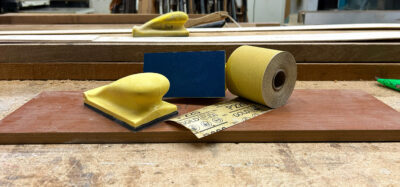
My set is 9′ 6″ long. The wood handles are a good choice. I treated them with a boiled linseed oil and turpentine mix per a suggestion from the maker. I am satisfied with the purchase.
I have a brand-X oar bag from a well-known company; these oars won’t fit only because I choose to leave the oarlocks attached. What does work are the sturdy and versatile pipe storage bags intended for pipe and drape tubing for trade-show and event booths.
The Gaco locks work just fine if you cut the gate at the top off. Makes getting underway a one handed job. Insert oar lock, drop in oar. Also makes it possible to switch oarlocks.
Interesting idea. Maybe I’ll try using them without snapping the top into place before performing surgery.